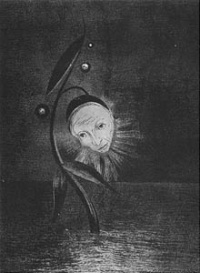Clown
From The Art and Popular Culture Encyclopedia
|
Where are the clowns? --"Send In the Clowns" (1973) by Stephen Sondheim |

Illustration: La Fleur du marécage (1885) by Odilon Redon
|
Related e |
|
Featured: |
A clown is a comic performer who employs slapstick or similar types of physical humour, often in a mime style. Clowns have a varied tradition with significant variations in costume and performance. The most recognisable clowns are those that commonly wear outlandish costumes featuring distinctive makeup, colourful wigs, exaggerated footwear, and colourful clothing. Their entertainment style is generally designed to entertain large audiences, especially at a distance.
History
Clowning is a form of entertainment that has appeared in some manner in virtually every culture. In most cultures the clown is a ritual character associated with festival or rites of passage and is often very different from the most popular western form. In Europe, up until as late as the 19th century the clown was a typical everyday character, and often appeared in carnivals. The performance is symbolic of liminality - being outside the rules of regular society the clown is able to subvert the normal order, and this basic premise is contemporarily used by many activists to point out social absurdity.
A popular early form of clown was the fool, a role that can be traced back as far as ancient Egypt and appears as the first card in the tarot deck. Most fools suffered from some physical or mental deformity, and were given to the local landlord as a charge, because their families were unable to look after them, and the surrounding communities often feared them. They were the butt of jokes, and their masters had the power to inflict violence upon them and even take their lives. However, being perceived 'idiots' they were often the only people in court who enjoyed free speech, and during the 16th century, especially in France, actors began to train as fools often in order to have the ability to make satirical comment. This is mainly where we get the contemporary idea of the court jester, immortalised and romanticised by actors such as Danny Kaye in The Court Jester. There is evidence of the 'wise fool' similar in function to the jester in many other cultures.
Clowns of this era and eras previous to it were also associated with jugglers, who were seen as pariahs of society alongside actors, prostitutes and lepers, and thus (at least in Europe) wore stripes, or motley - cloth associated with marginalised people such as the condemned, with strong associations with the devil. Jugglers often used clowning techniques, and the later court jesters often danced, performed acrobatics and juggled.
During the 16th century the Commedia dell'arte also became a huge influence on perceptions of the clown in Europe, and influence which passed through pantomime, into vaudeville and on to the touring circuses of the 19th and 20th centuries. The Commedia took influences from the grotesque masked clowns of carnivals and mysteries, and began in market places as a way to sell vegetables. It became incredibly popular throughout Europe amongst both the general public and the courts. The stock characters of the commedia originally included the Zanni - peasant clowns, Pantalone, the old Miser, Il Dottore - The Banal Doctor, and then grew from there to incorporate the Lovers, Arlecchino, Pedrolino, and Brighella, who have survived into the twentieth century in one form or another.
See also

